Selling Melt and Pour Soap
by Kim of Pepo Park
Congrats! The soaping bug has bitten and you want to spread your love for melt and pour soap. Be sure to check out part 1 and 2 of the series (here and here).
You shouldn’t rush to get your soap to market until you know all about your soap and fortunately, it’s easier to do with melt and pour than with cold process soap.
Scent and color: Melt and pour base with lower melting points hold low-flashpoint scents better than bases with high melting points. On the Bramble Berry site, all essential and fragrance oils have their flashpoints listed. Once you know the melting point of your base, you should be able to figure out if your scent will flash out or not. Color can be tricky. Any FD&C colors are dyes and dyes bleed. This is only an issue if you use more than one color in your soap (or if you care). Labcolors are dyes and they create bright colors. There are several articles on the Soap Queen site about their usage. Oxides, ultramarines and clays don’t bleed and natural micas are another non-bleeding colorant choice. However, some micas are tinted with FD&C colors and they will bleed. The color from any botanicals you add will also bleed out into the soap in the surrounding area.
The gorgeous colors in this photo were created using the Jewelry Box collection. They’re part of the Soapylove line at Bramble Berry and, because they bleed (they are dyes), can be used to create amazing effects.
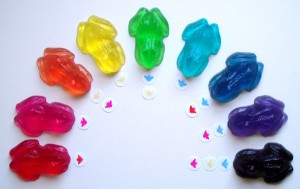 Gorgeous colors created by Debbie Chialtas using the Jewelry Box colorant collection.
Gorgeous colors created by Debbie Chialtas using the Jewelry Box colorant collection.
Freshness: Melt and pour soap should be wrapped in some kind of plastic. You can bag it or wrap it as long as you protect it from moisture. Any moisture in the air will cause glycerin in the soap to form small beads on the soap’s surface, also known as glycerin dew or sweat. Like cold process soap, it could also go moldy if you add too many botanicals or if they’re too fresh. For example, if you like to add fruit to your soap. Dried botanicals and fruit powders will work best.
Hardness: Bar hardness is generally not an issue with melt and pour soap unless you add extra oils. Doing so can make the bar softer and decrease lather.
Labeling: As mentioned in Part One, true soap doesn’t require an ingredient label. Your soap is true soap if it is made of fats and an alkali (lye). Check with your supplier to see if the soap base is made of fats and lye, synthetic detergents or a combination. If your soap base is made from synthetic detergents it is considered a cosmetic and must have all ingredients listed. If you buy your bases from Bramble Berry, every listing on the site includes the ingredients. Aside from ingredients, other information may be required by law (product weight and contact information) or desired by your customers (scent). It may be the only chance you have to communicate with your buyer. There is a great book called Soap and Cosmetic Labeling that will help you make sense of all of the rules. You can also read this page on the FDA site. If you decide that your soap is true soap, your customers will appreciate you listing the ingredients even if it’s not required.
Selling in the sun: If you’re selling melt and pour soap at an outdoor event, you soap can and will melt in the sun. In addition, the sun will fade out the colors. Keep your product cool and shaded.
In Part One, I talked about general issues like labels and packaging. Part Two discussed issues specific to selling cold process soap.
Written by: Kim Wilton of Pepo Park. Thanks to Erin Pikor of Naiad Soap Arts for contributing her knowledge of melt and pour soap making.

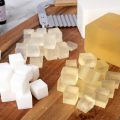
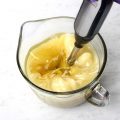
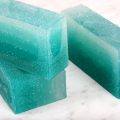
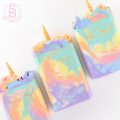
I have my first big order for a sweet 16 party. 80 cupcakes I am gonna be soaping for a week! I have her order priced as follows. $120.00 for soaping supplies. I ask for that upfront. I am giving her a discount of $2.00 per soap cupcake. Her cost per each is $5.00. So as to keep fair I gave her a discount on paying up front. Tax free. I was thinking since it is my first order and to get my name out there I would just charge her for the supplies+S&H+$250.00= making her total $400.00. So basically $120.00 off her order. I would still make in profit of $280.00. Does that sound fair? Or should I go with the $400+S&H+Supplies making her total $550.00? I feel since I will have some supplies left over that it would be fair but not sure? Any advice is welcomed, Happy Soaping! 🙂
I think that whatever you feel is the fairest for you and that you can make a profit from is what you should go with. If she is willing to pay more, you can always try that route. And, if she asks for a discount, you can give her one. Again, I would just make sure you are paying yourself, paying for your ingredients and paying for your time making them. I hope this helps. I’d also try asking this over at the Teach Soap Forums as there is plenty of crafters over there that can give you more advice on how to price your products. 🙂
Teach Soap Forums: http://www.teachsoap.com/forum/
-Becky with Bramble Berry
Thanks Becky. I cannot stress how much u have helped me!
Hello, I am a newbie soaper. I just wanted to say thanks for the 3 part series on selling soap and all the info related to cold process. I have gone through my ingredient list and prices. I get the jest of selling. I priced my soap cupcakes @ $7.00 + S&H. To make 12 cupcakes it costs me roughly $40.00, but I do not have enough stock so I have to order everything. My soaps are about 6 oz. a piece. Does this price sound fair? I would ask $10.00 but am afraid that people will be scared away especially in this economy. Did I price right??
Good morning, Jennifer!
I think that sounds like a super fair price, especially for the amount of time and ingredients you are putting into it. Have you had a chance to take a look at our links on the Teach Soap Website on how to price your products yet?
Pricing Your Melt and Pour Soaps: http://teachsoap.com/pricing-your-melt-and-pour-soaps/
Pricing Your Cold Process Soaps: http://teachsoap.com/pricing-your-cp-soaps
These will be really helpful in figuring out what you should charge as well. =) And, people will typically pay a little more for a handcrafted, natural product that you made yourself.
-Becky with Bramble Berry
Hi,
Thank you for information part three. I am a little bit concern to keep my melt and pour soaps outside like craft fair or even when summer and I haven’t done this type of market before. Do you have any recommendation to keep soap in stock in good temperature and will be able to show my customers to enjoy our soaps.
thank you in advance!
Good morning, Wansada!
That’s a great question! When you are selling your soaps at an open-air market outside, there are a couple of different options you have.
For melt and pour (M&P) soaps, make sure that they are fully wrapped in plastic (so they don’t sweat) and kept out of the direct sunlight.
If you have made cold process (CP) soap, you want to make sure your soap can breathe, so make sure it isn’t covered up entirely, we often use shrink wrap bands to help keep them nice, but allow them to breathe (as well as having a way the customers can smell them).
Shrink Wrap Soap Bands: https://www.brambleberry.com/Shrink-Wrap-Soap-Bands-250-wraps-P4975.aspx
I’d also try asking this question on the Teach Soap forums, as many of the soapers there often attend markets and fairs and could give you some excellent advice.
Teach Soap Forums: http://www.teachsoap.com/forum/
Happy Soaping!
-Becky with Bramble Berry
Hi Courtney, I am new to making soap, so new I haven’t made my first batch! But I am researching and I was thinking of wrapping my soap in wax paper but will that protect it from sweating? I really rather not use plastic.
Thanks, Denny! Best wishes with your soapmaking. 🙂
This may be a dumb question or simply a “newbie” question but is the melting point at what temp. the soap will melt or how hot it will get when it does melt? If it is how hot it gets when it does melt, is this why it affects the scent?
The melting point is the temperature at which the soap will start to melt. Our bases have a melting point between 120-125 degrees.
If the soap gets scalding hot it can cause the fragrance oil to vaporize, but we’re talking between 160 and 170 degrees before that can happen.
Courtney from Bramble Berry
Thank you! That makes sense
Hi Courtney! Thanks very much. Now to note that in my book from SWI.
How do you learn the melting point of your M&P base? Do you take the temperature when it’s melted? Does the vendor provide that information?
Your vendor can provide that information for you. Most of our bases have a melt point of 120 degrees.
Courtney from Bramble Berry
Thanks for this great series of posts with great information! Thanks for sharing. I visited your website. Your soaps are just amazing!